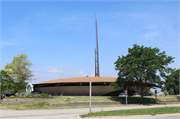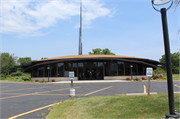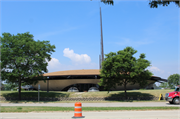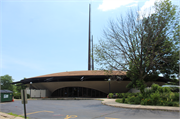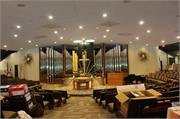Property Record
1700 S GREEN BAY RD
Architecture and History Inventory
| Historic Name: | Mount Pleasant Lutheran Church |
|---|---|
| Other Name: | |
| Contributing: | |
| Reference Number: | 10554 |
| Location (Address): | 1700 S GREEN BAY RD |
|---|---|
| County: | Racine |
| City: | Mount Pleasant |
| Township/Village: | |
| Unincorporated Community: | |
| Town: | 3 |
| Range: | 22 |
| Direction: | E |
| Section: | 24 |
| Quarter Section: | NW |
| Quarter/Quarter Section: | NE |
| Year Built: | 1975 |
|---|---|
| Additions: | |
| Survey Date: | 19752019 |
| Historic Use: | house of worship |
| Architectural Style: | Usonian |
| Structural System: | |
| Wall Material: | Unknown |
| Architect: | Helmut Ajango; Gene La Muro |
| Other Buildings On Site: | |
| Demolished?: | No |
| Demolished Date: |
| National/State Register Listing Name: | Not listed |
|---|---|
| National Register Listing Date: | |
| State Register Listing Date: |
| Additional Information: | A 'site file' exists for this property. It contains additional information such as correspondence, newspaper clippings, or historical information. It is a public record and may be viewed in person at the Wisconsin Historical Society, State Historic Preservation Office. SIMILAR TO GREEK ANNUNCIATION CHURCH IN WAUWATOSA. 2019: "Mount Pleasant Lutheran Church was designed by architects Helmut Ajango and Gene La Muro and built in 1975.(1) According to the WHPD, the church was designed in a “Wrightian” style and is noted as being similar to the Frank Lloyd Wright-designed Annunciation Greek Orthodox Church in Wauwatosa (AHI #8918), a National Historic Landmark. The church itself has a saucer-like appearance and is referred to locally as the “spaceship church.” (2) The church consists of a concrete base and metal roof described as “…essentially a dish with an inverted saucer as its roof.” (3) Connecting the two elements is a clerestory of plate glass windows lighting the interior of the church. Evenly spaced pointed brackets extend out from beneath the roof. These brackets join to structural steel beams that support the roof structure, but their exterior articulation is also said to symbolize Christ’s crown of thorns. The church contains three entrances. The main entrance faces southwest and includes a prominent glass-walled enclosure that was constructed in the 1990s. The second entrance faces east and the third entrance faces northeast opposite the main entrance. The secondary entrances echo the saucer-like shape of the building with a long arc at their base. A 120-foot spire is centrally located on the roof of the building and consists of three individual steeples of varying widths and heights joined together at the bottom by welded horizontal metal rods. The primary entrance leads to the narthex, which resembles a glass atrium. The area is surrounded by glass walls and contains a rock garden and decorative plantings. The sanctuary is located at a higher level and accessed by a series of ramps. The sanctuary itself is centered around the altar with sloped floors and pews arranged in a semi-circle. Ramps also lead to lower basement levels of the church which were added in the 1990s when more space was needed. At that time it was decided that above-ground additions to the building’s footprint or the addition of a second building on the property were not options in order to protect the original design of the church. (4) Instead, the church was expanded underground.(5) The new buried wing added 14,000 square feet and was completed in 1997. It included a new education wing and library as well as a new kitchen and fellowship hall. To allow natural light to the newly designed basement interiors, two 7-foot diameter domed skylights were included. These can be seen emerging from the ground and framing the east side of the church looking west from STH 31.(6) A new narthex (previously described), updated carpeting, and a modern sprinkler system were also part of that project. (7) The current pipe organ was installed in 2006, just a year after the curvilinear walls were added behind the altar in order to improve the acoustics for musical performances. The central ceiling shell was added in 2005 as well, which was originally a continuation of open rafters. Most recently, new carpeting was installed in the sanctuary in 2013. Other changes include the paving of the current surface parking lot between 2015 and 2017. (8) In 1858, a church was built at the intersection of STH 31 and STH 20 (Mygatt’s Corners) for the First Freewill Baptist Society. In 1947, Atonement Lutheran Church leased the church, which then became known as Mygatt’s Corners Lutheran Church and later Mount Pleasant Evangelical Lutheran Church. The present church was built in 1975 on land acquired two years prior from Lincoln Lutheran of Racine. Construction was financed in part by the sale of the previous church property.(9)" |
|---|---|
| Bibliographic References: | (1) Mount Pleasant Lutheran Church, “A Long and Colorful History,” accessed October 2, 2019, https://spaceshipchurch.org/about/our-building/a-historical-summary/. (2) Mount Pleasant Lutheran Church, “A Long and Colorful History.” (3) Mount Pleasant Lutheran Church, “A Long and Colorful History.” (4) Mount Pleasant Lutheran Church, “A Long and Colorful History.” (5) “Answer to Church’s Space Problem Lies Beneath the Earth,” The Journal Times, May 10, 1996. (6) “Answer to Church’s Space Problem Lies Beneath the Earth,” The Journal Times, May 10, 1996. (7) Mount Pleasant Lutheran Church, “A Long and Colorful History.” (8) Mount Pleasant Lutheran Church, “A Long and Colorful History.” (9) Mount Pleasant Lutheran Church, “A Long and Colorful History.” |
| Wisconsin Architecture and History Inventory, State Historic Preservation Office, Wisconsin Historical Society, Madison, Wisconsin |

